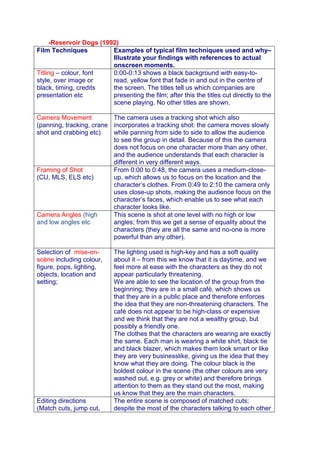
Reservoir Dogs
- 1. -Reservoir Dogs (1992) Film TechniquesExamples of typical film techniques used and why– Illustrate your findings with references to actual onscreen moments. Titling – colour, font style, over image or black, timing, credits presentation etc 0:00-0:13 shows a black background with easy-to-read, yellow font that fade in and out in the centre of the screen. The titles tell us which companies are presenting the film; after this the titles cut directly to the scene playing. No other titles are shown.Camera Movement (panning, tracking, crane shot and crabbing etc)The camera uses a tracking shot which also incorporates a tracking shot: the camera moves slowly while panning from side to side to allow the audience to see the group in detail. Because of this the camera does not focus on one character more than any other, and the audience understands that each character is different in very different ways.Framing of Shot (CU, MLS, ELS etc)From 0:00 to 0:48, the camera uses a medium-close-up, which allows us to focus on the location and the character’s clothes. From 0:49 to 2:10 the camera only uses close-up shots, making the audience focus on the character’s faces, which enable us to see what each character looks like.Camera Angles (high and low angles etcThis scene is shot at one level with no high or low angles; from this we get a sense of equality about the characters (they are all the same and no-one is more powerful than any other).Selection of mise-en-scène including colour, figure, pops, lighting, objects, location and setting;The lighting used is high-key and has a soft quality about it – from this we know that it is daytime, and we feel more at ease with the characters as they do not appear particularly threatening.We are able to see the location of the group from the beginning; they are in a small café, which shows us that they are in a public place and therefore enforces the idea that they are non-threatening characters. The café does not appear to be high-class or expensive and we think that they are not a wealthy group, but possibly a friendly one.The clothes that the characters are wearing are exactly the same. Each man is wearing a white shirt, black tie and black blazer, which makes them look smart or like they are very businesslike, giving us the idea that they know what they are doing. The colour black is the boldest colour in the scene (the other colours are very washed out, e.g. grey or white) and therefore brings attention to them as they stand out the most, making us know that they are the main characters.Editing directions(Match cuts, jump cut, reverse shots etc)The entire scene is composed of matched cuts; despite the most of the characters talking to each other in a group conversation there are no reverse shots to show who is talking. At 0:48 one man is shown to be eating while another man is talking, but we do not see the man that is talking.Sound techniques(diegetic, non diegetic, silence, dialogue There is no background music in this scene at all, which strengthens our impression that these men are normal people and similar to the viewer (there is no music that implies that something suspenseful is happening). There are some diegetic sounds such as cutlery and plates clinking, however the majority of the scene is taken up by dialogue. Most of the time we are unaware of which character is speaking as they are not specifically shown onscreen, but we understand that most of the group is having a conversation. Due to the nature of the conversation and the high amount of swear words used we can assume that they are taking a break from a mundane job and having a conversation amongst friends, where no-one will mind what they say, although one character is not paying attention to what everyone else is saying.Actor’s positioning and movementBecause there is usually more than one character being shown in any shot (which is constantly moving), no-one is at the centre or the side of the shot for a long period of time. In the shots where a single character is shown, i.e. 1:10-1:14, that person stays in the centre of the screen until the camera moves onto the next character, which happens quickly – showing us that all the characters are important and integral to the plot.No-one moves lots, although the characters that talk the most also have the most movement such as moving their hands around while they talk, which tells us that they are more animated than the other characters. -0:12; the titles are very clear against the background. Non-diegetic dialogue is playing before the scene begins. -0:48; medium shot of many characters. They are shown as being equal as the camera doesn’t focus on any particular character and is instead constantly moving and panning. -1:01; close-up shot of the character that is speaking. Even when one character is being shown the camera is constantly moving; the camera has just panned from another character to the one being shown.